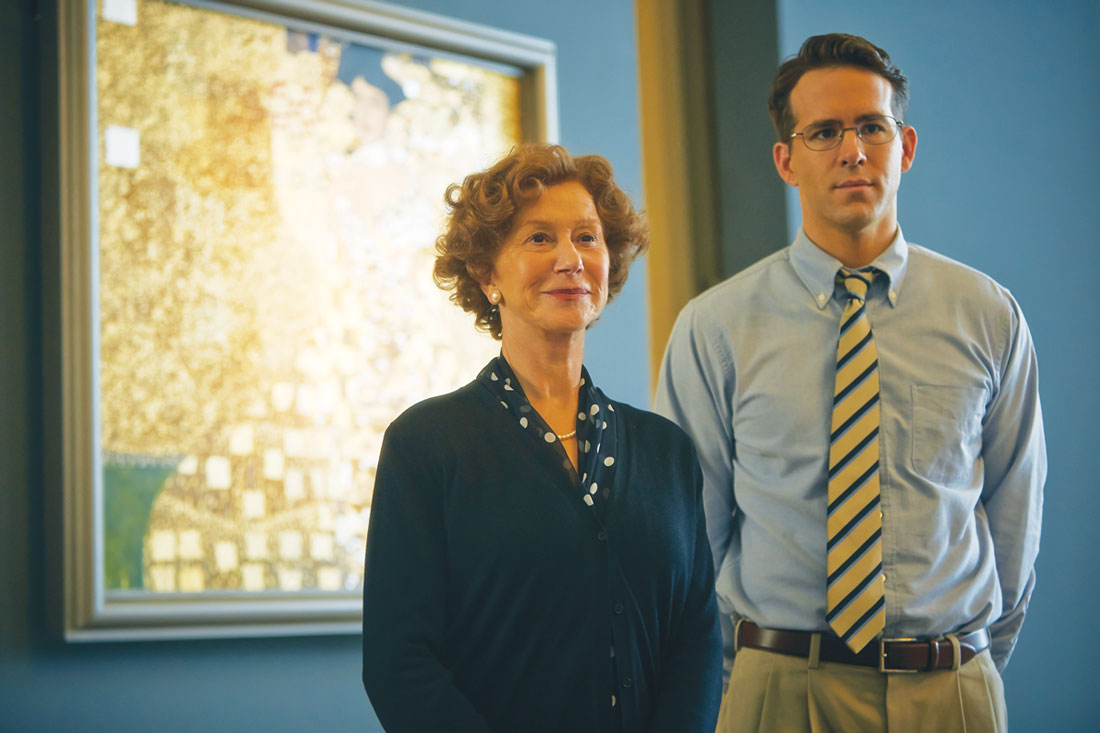The story of how the Nazis looted Europe’s storehouses of art masterpieces is a compelling one, whose salient details only came to light within the last few decades. It should make for a terrific movie. People are trying to make that movie, but so far there hasn’t been much success. George Clooney’s The Monuments Men bit off more than it could chew, so now Woman in Gold focuses on one sliver of this wide-ranging saga. Unfortunately, this latest film is an example of old-school Hollywood at its worst, a synthetic drama devoid of any originality or genuine feeling that reduces an inspiring real-life legal odyssey to a hackneyed tale of the little guy triumphing over impossible odds.
The title refers to Gustav Klimt’s painting, formally titled “Portrait of Adele Bloch-Bauer I,” though subsequent owners referred to it as “Woman in Gold” to hide the subject’s Jewish origins. The story picks up in 1998 in Los Angeles, where Adele’s niece Maria Altmann (Helen Mirren) has settled after fleeing her native Austria during the 1930s. After her sister’s death, Maria finds documents pertaining to her family’s ownership of the artwork, which was confiscated from her family by the Nazis and now hangs proudly in one of Vienna’s most famous museums. She engages a friend’s son, a struggling lawyer named E. Randol Schoenberg (Ryan Reynolds), to find out if she has a case. Despite knowing little about art and despite the disapproval of the big law firm that just hired him, Randy discovers that Maria can sue for the return of her family heirloom that just happens to be a masterpiece of Art Nouveau portraiture.
This is directed by Simon Curtis, the British filmmaker who reduced movie history to a wax pageant in My Week with Marilyn. This film is even more stilted, with screenwriter Alexi Kaye Campbell providing cheap applause lines and Curtis holding our hands so that we’re never unsure about how to feel about what’s unfolding. Some poorly handled flashbacks to young Maria (Tatiana Maslany) and her escape from her Nazi-controlled homeland fail to generate any suspense or danger, and further flashbacks to Adele herself (Antje Traue) looking at her portrait with little Maria (Nellie Schilling) give us little about the connection that Maria feels to the woman in the painting. Likewise, we see Randy visit the Holocaust memorial in Vienna, yet we’re left clueless as to why it takes that to make him aware of his own Austrian heritage. Randy is early on revealed to be the grandson of the great composer Arnold Schönberg, but this potentially fascinating detail goes nowhere, even when Randy attends a concert of his grandfather’s music. If you’re looking for any insight into the painting’s merits as a work of art, you’re out of luck there as well.
Instead, we get Maria, Randy, and a sympathetic Austrian journalist (Daniel Brühl) butting heads with callous government officials and lawyers who refuse to let “the Mona Lisa of Austria” leave the country or admit how the painting came to be hanging in the museum. These are cardboard villains, and it isn’t much fun watching them be taken down. There’s also the obligatory joke where some clueless American mistakes Austria for Australia.
The subject matter has attracted all manner of name actors to fill out small roles: Katie Holmes as Randy’s wife, Charles Dance as his boss, Elizabeth McGovern as a California judge, Jonathan Pryce as Supreme Court Chief Justice William Rehnquist. As estimable an actor as Moritz Bleibtreu is brought on in a prologue to deliver two lines as Gustav Klimt. Yet for all they’re given to do, any actors could have easily played these roles. The flashback sequences feature some impressive work by Anglophone actors performing almost entirely in German, but the material they’re given is watered-down melodrama. As for the leads, this is more than Mirren can manage, as she’s left to look various degrees of aggrieved, nostalgic, and determined. Reynolds, a terrific comedian who has made disastrous choices as a leading man (Green Lantern, R.I.P.D.), looks convincingly out of his depth in the early going and then gains in stature once Randy resolves to carry on the case when Maria is ready to concede defeat. He also manufactures a funny bit involving a business card.
This film’s comprehensive failure leaves me to recommend that you buy a Gustav Klimt refrigerator magnet instead of seeing Woman in Gold. Not only will it be a better use of your money, you’ll have a more meaningful artistic experience from it.
[box_info]Woman in Gold
Starring Helen Mirren and Ryan Reynolds. Directed by Simon Curtis. Written by Alexi Kaye Campbell. Rated PG-13.[/box_info]











